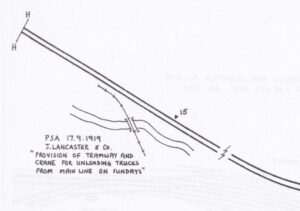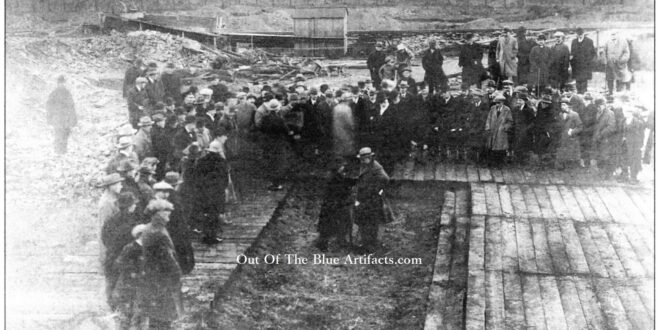 The New Colliery – Aberbeeg.
The New Colliery – Aberbeeg.
Monmouthshire, post-war 1918, the Messrs J. Lancaster & Company with the Ebbw Vale Company planned to sink a new colliery in the Cwm Valley at Aberbeeg.
Arrangements were made with the Great Western Railway Company to install railway sidings with a bridge over the river (as seen left) branching off the main line from Aberbeeg to Cwm. The map dated 17th December 1919 shows the sidings were laid down over the river for Messrs J. Lancaster & Co for a provision of a tramway and crane for unloading trucks from the main line on Sundays. A short while later it was reported the colliery was still in the planning procedure but owing to the uncertainty of the financial situation at this time, it was again put on hold, though in 1920 Messrs J. Lancaster & Company decided to proceed with its construction and the work on its sinking went ahead.
The Ceremony of Cutting the Sod.
On Saturday 4th of December 1920, the new colliery undertaking went ahead by the J. Lancaster & Co at Aberbeeg, the first sod was cut by Lady Mather-Jackson J.P., O.B.E. Those present at the cutting of the sod (as in the image above) were – Sir Henry Mather-Jackson and Lady Mather-Jackson, BT., O.B.E., J.P.; Sir John Beynon BT., C.B.E., and Miss Beynon, Mr F. Mills (Chairman of Directors); Lieut-Col Charles Kirk and Mrs Kirk; Mr A. B. Sweet-Eacott, (General Manager of the Ebbw Vale Company) and Mrs Sweet-Eacott; Mr B. Northgraves Secretary; Mr W. H. John (Chief Colliery Manager); Captain R. A. Lewis (Works Manager); Captain W. M. B. Burnyeatt M. C. (Estate Agent); Mr L. F. Beynon; Mr Ben Owen (Chief Colliery Manager of the Messrs John Lancaster Powell’s Tillery Group of Collieries); Mr T. Jenkyn Williams (Chief Colliery Manager of the Cwmtillery Group); Mr W. H. Rolfe (Secretary of the Cwmtillery Colliery Co); Mr D. A. Jones (Agent of the Abercarn Collieries); Councillor Jack Games; Mr Felix Budd; Rev H. S. Rees; Dr T. B. Smith; Messrs G. Hay Morgan; K. C. (Liberal-Coalition candidate for the Abertillery Division); Mr George Barker (Miners Agent and Labour candidate); Opton Purnell; Mr T. J. Thomas (Engineer to the Ebbw Vale Urban District Council) and Mr John Williams (Engineer to the Abercarn Council):
After the cutting of the sod by Lady Mather-Jackson they all retired to a tea held in a marquee close by, after the speeches Mr Ben Owen presented Lady Mather Jackson with a silver card-tray, inscribed with the words “Presented to Lady Mather-Jackson J.P., O.B.E., by the officials of Messrs J. Lancaster & Co Ltd, on the occasion of the inauguration of the new pits at Aberbeeg, December 4th 1920”. Mr Owen also said, “The next time Lady Mather-Jackson came to Aberbeeg it would be to open the pithead baths at the site”.
The Colliery Details.
The new colliery shafts would have been 20′ feet in diameter and 500 yards (1,500′ feet) deep and sunk to the Old Coal Seam, it was said that there were an estimated 1,200 acres of coal available and the output – when the pits were fully developed the estimated out-put was said to have been 1,000,000 tons per year. The colliery would have been electrically equipped throughout, the power being obtained from the electrical generation station at Victoria, Ebbw Vale and transmitted by an overhead line at 20,000 volts to Aberbeeg where it would have been transformed to a working voltage of 2,000 and 500.
The Six Bells power station would also have been coupled up to Aberbeeg and would have acted as an emergency service in the event of any interruption in the supply from Victoria. When the colliery was fully developed employment was said to have been for 2,500 men, it was intended to work the colliery entirely by mechanical means. Coal cutters and conveyor belts would have been used throughout and the use of horses would have been eliminated.
The Location of the New Colliery.
The location of the new colliery was a little further up the Cwm valley from the Aberbeeg North Pit not far from the Ivorites Arms.
The Financial Situation and the Colliery.
After the initial sinking ceremony, the financial state of the country made the owners and shareholders think twice about the future construction and development on such a large scale and plans were once again shelved. A short while later the Messrs J. Lancaster & Company seemed to abandon the new colliery completely.
The Resumption of the New Colliery Project.
On Friday 8th of May 1925, it was reported that the company had made a start to resume the sinking of the abandoned new colliery. The railway bridge which carried a single track into the site was being repaired and strengthened and the one shaft was sunk to the “hard” which was said to have been about 120′ feet in depth, the surface was scraped off the other shaft in readiness for its sinking.
The Later Years.
A short while later the company’s plans were put on hold yet again and this so-called “super colliery project” was again abandoned, later forgotten.
The top sections of the bricked shafts can still be seen today.
 Out Of The Blue Artifacts A Library of a lifetime of collecting
Out Of The Blue Artifacts A Library of a lifetime of collecting
